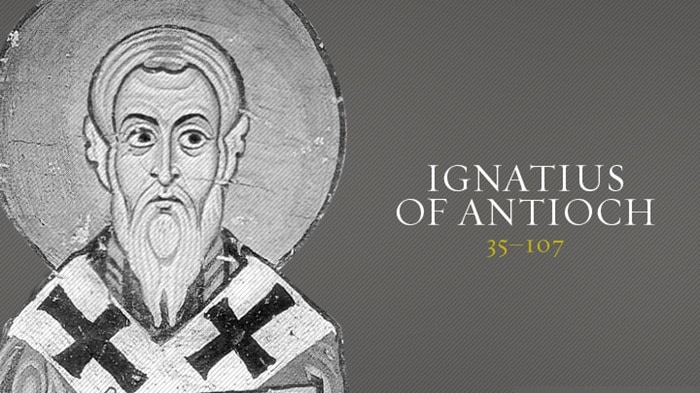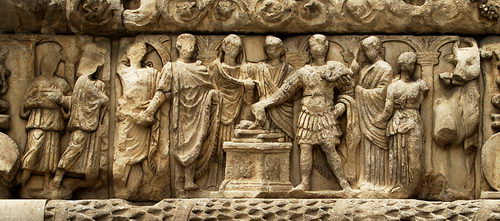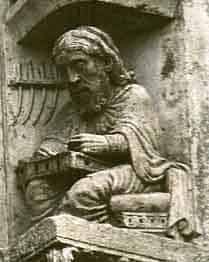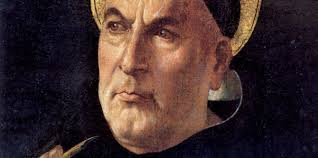This Episode is titled, “What Shall We Call Them?”
The survival of the Christian church in the 2nd & 3rd Cs is surely a testimony to the favor of God. Any objective consideration of the challenges faced by the Christian community during this time has to wonder at the tenacity of the followers of Christ. This was a 200 yr period when they faced constant challenges from heretics & false teachers, as well as intense external pressure in the form of persecution.
It was also a time in which Christian theology was still being developed & local churches improvised how they were led. Let’s take a closer look at how the leadership of the Church developed during this crucial time of formation.
Little is given in the NT by way of a design for church government. What we find is a description of the character of those who serve as elders and deacons. But precisely what these offices were to do isn’t spelled out. We can only infer their duties from the word used to describe them. Since the term ‘elder’ is synonymous with ‘pastor’ in the NT, the elders were to lead, feed & protect the flock of God. Deacons, as their title suggests, performed a ministry of practical service in attending to the physical needs of the fellowship.
In Acts, we see the Apostle Paul ensuring the churches he started had some form of pastoral leadership when he left. From his letters, we glean there were 2 classes of church leaders; itinerant & resident. One group, comprised of Apostles, Evangelists & Prophets moved from place to place, while Pastors & Deacons serviced a single congregation or tended a limited region were several smaller fellowships met.
Ignatius of Antioch gives an important insight into the maturing of church leadership that took place at the beginning of the 2nd C. In order to make sure each congregation was well served by its leaders, Ignatius argued for a single, pastor-elder to lead the church, assisted closely by a group of fellow-elders & deacons. Though the word ‘bishop’ simply means ‘overseer’ & is synonymous with the elder & pastor, the lead-elder was given the title of “bishop.” Ignatius urged churches to adopt this model of leadership.
This form of church government facilitated communication within & between churches. With a bishop in each congregation, there was now one person to ensure communication with other congregations & their bishop. Having a bishop helped ensure a consistent policy in the distribution to the poor & produced a consistent voice in dealing with the challenge of false teachers.
It was a few decades until Ignatius’ Bishop-Elders-Deacons form of church government was broadly established, but it eventually became the model most congregations adopted. Yet even when churches embraced it, they implemented it differently. For instance, in Asia & Africa, each local congregation had its own bishop. In Western Europe, a bishop of a church in a large city often exercised oversight in the smaller churches of surrounding towns & villages by appointing their elders & pastors.
By the late 2nd C, the undisputed leader in church affairs was the bishop. It was the challenge of Gnosticism that greatly encouraged this. Here’s why . . .
The Gnostics claimed an unbroken succession of specially enlightened teachers all the way back to Jesus. They claimed Jesus entrusted a secret message to the Apostles, who in turn passed it on to others & of course, the Gnostics were the latest in that succession of enlightenment, who for the right price would impart that secret knowledge to the next generation of Gnostics leaders.
In countering Gnosticism, the Church emphasized the public, rather than secret, character of the Gospel as openly taught by Jesus & His Apostles. They stressed that the tradition of the Apostles had not gone underground but that those leading the churches of the 2nd C could trace their connection to Jesus thru the Apostles by a visible line of communication & affirmation. Crucial to this argument was the role of those churches that had been established by the original Apostles & their close associates, the Apostolic Fathers. In the 2nd C, the list of those who’d served as the lead-elders wasn’t something lost to the mists of time. People knew who’d been the pastors at Corinth & Ephesus, in Rome & Smyrna, and other keys churches.
In the mid-2nd C, an historian named Hegesippus made a trip from Israel to Rome, interviewing bishops all along the route. Now—check this out because it’s super-important. Hegesippus discovered the bishops all shared the same message and viewed the Faith in the same way. They also went about their task of leading the church in the same general manner. He wrote, “In every succession and city, what the law and the prophets and the Lord preached is faithfully followed.” Hegesippus even drew up lists of bishops, showing their succession in unbroken lines going back to the Apostles.
Not long after Hegesippus, Irenaeus in Western Europe & Tertullian in North Africa filled out the succession picture for the bishops in their regions.
The point is this – By the dawn of the 3rd C, each local congregation, in the larger cities at least, had a lead-elder who functioned as what today we’d call a senior pastor, but known in that time as a bishop. This bishop was assisted by a close group of fellow elders who oversaw the spiritual needs of the congregation, while their physical needs were met by a group of deacons.
The development of this form of church government was in all likelihood encouraged by the model of the Jewish synagogue, as well as the nature of group dynamics. Whenever a group of people meet, it’s inevitable one will rise to take the lead. Even among leaders, one of them will tend to be invested with the role of taking the lead so the work of the group is more efficient. As one elder in a church was invested with this lead-role, the other elders & the church as a whole recognized the advantage of having one man who was called by God to lead them. When the threat of false teaching, such as Gnosticism, presented a challenge to the Faith, it further advanced the role of the bishop, who met with other bishops to develop a united response to the new threat.
These gatherings of bishops to address issues of interest & concern to the Faith became a crucial part of the history of the Church. Known as Councils & Synods, they will see the major issues of the day brought forward for consideration and debate.
I want to pause at this point & recognize that the emergence of the role of bishops in leading the Church is a point of major controversy; not that bishops did in fact become the de-facto leaders of the church, but what that development MEANS. Some claim the rule & role of bishops was the plan & will of God. Others see it as a tragic departure from what Christ intended for His followers. Still others would say that it wasn’t the development of this form of church government that was the problem; what became a problem was the quality & character of the men who became bishops.
Without question, what commended the faith to outsiders during the 1st thru 2nd Cs was the quality of the lives of believers. As we’ve considered in previous episodes, the rumors circulated about what Christians believed & practiced in secret were absurd, just crazy talk. Those who actually knew Christians put little stock in the rumors because of the exemplary morality they lived by. Christians understood the power of the Holy Spirit, not so much as something that manifested itself in spiritual gifts but as a moral energy that produced the fruit of the Spirit – love, joy, peace, patience, kindness, goodness, faithfulness, gentleness, and self-control. This is precisely what the Apostle Paul told believers to look for as the evidence of the Spirit’s work.
The Early Church Fathers continued this emphasis. So much so that members who continued in sin were first rebuked, then removed from fellowship. But it wasn’t just Christians themselves who claimed a call to moral excellence. Outsiders gave testimony to the exemplary ethics and practice of Jesus’ people. In writing to the Emperor Trajan, Pliny, governor of a Roman province said that in his examination of Christians & their practices he was unable to find anything immoral; in all respects they were model citizens, except that they were part of an illegal sect. Justin Martyr says it was the moral attractiveness of the followers of Christ that moved him to consider their doctrine.
But something changed at the dawn of the 3rd C. The morality of the Church began to dim, not universally, but in certain places. This brings us back to the role of Baptism in both the ministry of the Church & in the individual lives of believers.
The Book of Acts presents water baptism in much the same way that some churches use an altar call today. It was a way for people coming to faith in Christ to make a public confession of their Faith. The Church used baptism as a way to give individuals a way to mark their inclusion in the Sacred Community = Communio Sanctorum. But over the next 200 yrs, that understanding of baptism morphed into a much more spiritually significant event. Baptism was thought to cancel all sins committed UP TO that moment. Following baptism, it was believed certain sins required special penance to be discharged, & if those sins were severe enough, they were beyond forgiveness. There were 3 sins that were considered especially heinous; apostasy, murder, & sexual immorality. These sins might be forgivable by God, but the Church could not restore the guilty to fellowship. Violators were excommunicated & denied access to Communion, which like Baptism had taken on more importance than as a memorial of Christ’s sacrifice. The elements of the Lord’s Supper were seen as spiritual food that nourished the grace by which believers maintained their salvation. So, to be cut off from Communion meant being in jeopardy of exclusion from those who attained heaven. Ignatius referred to the bread & wine as “the medicine of immortality & the antidote of death.”
The issues of bishops & baptism came together during the 1st half of the 3rd C. This was a time of relative peace for the Church when persecution at the hands of Roman officials cooled somewhat. In several places, Christians were not only tolerated, they gained favor. This favor resulted in a loosening & lowering of the moral expectations believers held toward each other. Sins that had before incurred rebuke were left unaddressed while those which had led to dis-fellowship were forgiven.
One of the first to grant reconciliation to repentant sinners was Callistus, bishop at Rome from 217 to 222. He restored repentant adulterers. Callistus likened the church to Noah’s ark, in which was contained both the clean & unclean. It was a school where sinners learned to be saints, a hospital where the sick could recover.
But then Callistus went further. He defended his position by claiming that à as the bishop at Rome he was heir to the authority of the Apostle Peter who’d received from Jesus the keys of authority to define Church b elief & practice, not just at Rome, but the ENTIRE Church. Those keys, Callistus said, included the power to either loose or bind the guilt of individuals. This was the first time such authority was claimed by a bishop of Rome.
When Tertullian, a leading bishop of North Africa heard this pronouncement by Callistus he was appalled and said, specifically regarding the issue of what to do with people who’d been excommunicated, “We do not forgive apostates. Shall we forgive adulterers?” Tertullian’s objection had traction with the previous generation but was no longer in favor among the churches of Europe. While Tertullian voiced the majority view of North Africa where he worked, the bishops & churches north of the Mediterranean agreed with Callistus. Their reasoning went further; If adulterers could be reconciled to fellowship, why not apostates? And so we see the scene set for the Novatianist & Donatist Controversies of the 3rd C we’ll considered in our next episode.
As we end this one, let me be clear. While Ignatius of Antioch was the earliest voice we have who advocated that local churches be led by a single elder-pastor, who we can think of as a senior pastor, but was given the title of bishop – Ignatius NEVER hinted at the idea that the ENTIRE Church ought to have a single Bishop.
It wasn’t until Callistus in the early 3rd C. that someone floated the idea that the bishop of Rome was not just the lead pastor of the capital, but of the Church everywhere. The bishops of the Roman church might indeed be dynamic leaders as befitting a church of thousands, but this idea of being the spiritual heir of Peter’s authority was something new.
Now, I know this is going to fire up some, but let me use an illustration to show HOW Callistus’ claim was received by the other bishops of the time. Imagine today that the pastor of one of the older & larger churches of your city, county, or province sent out a letter or email to the all other churches in the region, saying that BECAUSE his church was older & larger, he was now THEIR LEADER; they ought to obey him and defer to his decisions. How would that be received? Probably not so well.
Well – that’s how most bishops responded to Callistus’ claim. It was a combination of factors and differing opinions between a handful of lead churches in their respective regions that would see Rome & its bishop take on a larger role than just one of many churches. But that also, is the subject for a later episode.







A minor correction in Episode number “11 – What shall we call them” it is stated that Callixtus was the first to indicate that the Bishop of Rome had authority over the other Christian Churchs. The authority of the Church in Rome was already taught by Irenaeus in his against heresies in around 189AD the following is a direct quotation from Against heresies:
2. Since, however, it would be very tedious, in such a volume as this, to reckon up the successions of all the Churches, we do put to confusion all those who, in whatever manner, whether by an evil self-pleasing, by vainglory, or by blindness and perverse opinion, assemble in unauthorized meetings; [we do this, I say,] by indicating that tradition derived from the apostles, of the very great, the very ancient, and universally known Church founded and organized at Rome by the two most glorious apostles, Peter and Paul; as also [by pointing out] the faith preached to men, which comes down to our time by means of the successions of the bishops. For it is a matter of necessity that every Church should agree with this Church, on account of its preeminent authority, that is, the faithful everywhere, inasmuch as the tradition has been preserved continuously by those [faithful men] who exist everywhere.
“Adversus haereses” “Against Heresies” [3;3;2]
Irenaeus then proceeds to discuss in section [3;3;3] how Clement of Rome used the authority authority of the Roman Church with his epistle to the Carthaginians.
Dear Geniusboi –
Thank you for your feedback. Your point is well taken. However, the passage in Against Heresies needs to be considered carefully as there’s scholarly debate over precisely what Irenaeus meant.* (See below) Contextually, the case can be made that Irenaeus wasn’t establishing a case for Papal primacy so much as he was setting the Church at Rome as the standard bearer for orthodoxy – which fits the theme of the work & passage. The church at Rome did stand as a stalwart witness to the truth for those early centuries. It wasn’t until Callixtus I (Callistus I) a few years later that the Bishop of Rome made a claim to primacy. That claim, of course, didn’t arise out of thin air.
* The Latin text of this difficult but important clause is, “Ad hanc enim ecclesiam propter potiorem principalitatem necesse est omnem convenire ecclesiam.” Both the text and meaning have here given rise to much discussion. It is impossible to say with certainty of what words in the Greek original “potiorem principalitatem” may be the translation. We are far from sure that the rendering given above is correct, but we have been unable to think of anything better. [A most extraordinary confession. It would be hard to find a worse; but take the following from a candid Roman Catholic, which is better and more literal: “For to this Church, on account of more potent principality, it is necessary that every Church (that is, those who are on every side faithful) resort; in which Church ever, by those who are on every side, has been preserved that tradition which is from the apostles.” (Berington and Kirk, vol. i. p. 252.) Here it is obvious that the faith was kept at Rome, by those who resort there from all quarters. She was a mirror of the Catholic World, owing here orthodoxy to them; not the Sun, dispensing her own light to others, but the glass bringing their rays into a focus. See note at end of book iii.] A discussion of the subject may be seen in chap. xii. of Dr. Wordsworth’s St. Hippolytus and the Church of Rome.
Roberts, A., Donaldson, J., & Coxe, A. C. (Eds.). (1885). The Ante-Nicene Fathers: The Apostolic Fathers with Justin Martyr and Irenaeus (Vol. 1). Buffalo, NY: Christian Literature Company.
Thanks for the quick response. The podcasts provide a good view of christian history especially from the evangelical perspective. The reason I posted the initial comment is the fact that it should be made clear that Callixtus was not operating in a vacuum in the at podcast 15min 25sec this was strongly implied.
God Bless
Thanks PH. TUrns out the next episode I’m working on deals with Rome’s emergence under Damasus & Leo, so I’ll try to remember to bring this up.
That Great Good luck with the Latest Episode
Great explanation of church leadership.
Thanks
Raul